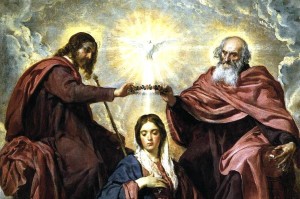 “And a great portent appeared in heaven: a woman clothed with the sun, with the moon under her feet, and on her head a crown of twelve stars” (Revelation 12:1).
“And a great portent appeared in heaven: a woman clothed with the sun, with the moon under her feet, and on her head a crown of twelve stars” (Revelation 12:1).
Today’s feast of the Queenship of Mary celebrates the coronation of Mary as Queen of the universe. This is another Marian teaching of the Church that non-Catholics have trouble with, because it’s scriptural roots aren’t as obvious as they often are for other doctrines. A proper understanding of typology, however, makes the Queenship of Mary stand out in sharp relief as one reads the sacred page.
What is typology? As one writer put it, “God writes the world the way humans write with words.” Human writers can use literary devices like foreshadowing to tip the reader off to what’s coming in the future. When God acts in the history of salvation, he works in a similar fashion. He uses not words, but events, places, and people during Old Covenant times to foreshadow even greater realities – events, places, and people – of the New Covenant.
One of those realities is the position of Queen. In the Old Covenant Kingdom of David, the Queen was not the wife of the King, but his mother – the Queen Mother. This position began under King Solomon, the son of David. Solomon had, of course, many wives, so rather than have them slug it out in some sort of mud wrestling match for the title, the crown went to Bathsheba, the king’s mother, who sat at his right hand.
In a similar way, the one the New Testament hails as “the Son of David” rules a Kingdom. Jesus calls it “the Kingdom of God – exactly what David’s kingdom was called in the OT. That kingdom has a Prime Minister, which we saw in this past Sunday’s readings is Peter, who holds the “keys of the kingdom”, like Eliakim did in Isaiah 22.
This Kingdom also has a Queen – a Queen Mother, Mary. This is why foreign dignitaries pay homage to Jesus as to a king, alongside his mother after his birth (Matthew 2:11), just as other rulers would have done in earlier times for Solomon in the presence of his mother.

